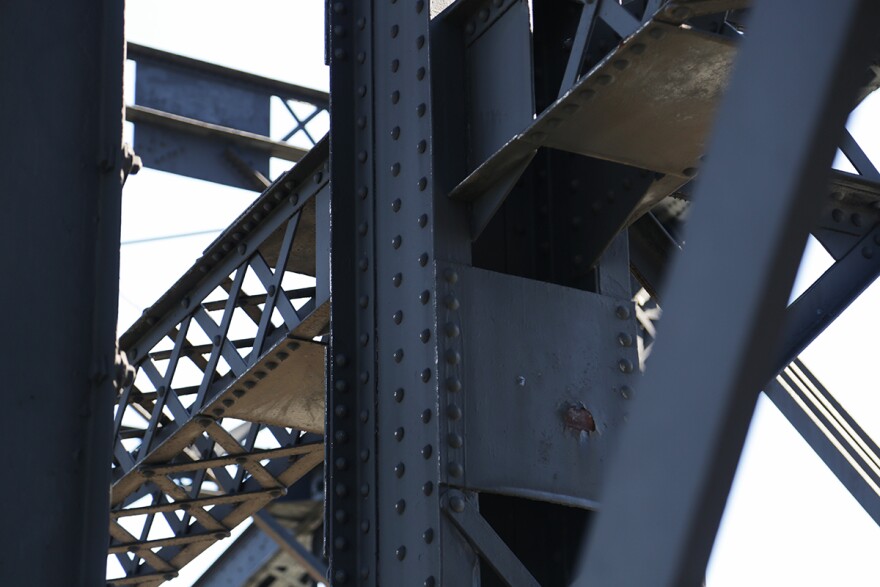City of Bridges: The following report is the last is a three-part series examining the status of Pittsburgh bridges as the Pennsylvania Legislature considers funding for transportation infrastructure.
Going only by the debate over transportation funding in the state capitol, some readers might have the impression that Pittsburgh’s bridge infrastructure is an unmitigated mess. They wouldn’t be entirely wrong about that: there are major structural issues with some of the city’s bridges, and even bigger political problems when it comes to funding the needed repairs. But there are also success stories, like the Hot Metal bridge.
The Hot Metal bridge bore witness to the rise and fall of industrial Pittsburgh, and in many ways it's symbolic of that transformation.
Officially known as the Monongahela Connector Railroad Bridge and Hot Metal Pedestrian Bridge, it stretches nearly 12-hundred feet from Second Avenue to the South Side, and it’s steeped in history at both ends. It’s actually two separate bridges that share the same set of piers. The first was built in the 1880s to carry trains over the river. The smaller pedestrian bridge came later, at the turn of the century. Both were integral to steel production during that period.
"They had steel complexes on either side of the river," said Katie Bates, with the Army Corps of Engineers. "The Eliza Furnace was right around this area, and all the steel mills would work with the same bit of steel so they would shuttle it back and forth. When it was in the liquid phase they built a bridge specifically to shuttle the steaming carts of molten steel across."
It would be more than a century before the structures were repurposed for their present use. In the interim, the Hot Metal bridge bore witness to the rise and fall of industrial Pittsburgh. And in many ways, it’s symbolic of that transformation.
"The bridges are a good emblem for what the city has been through," Bates said. "It was built in the 1880s as a really good way to produce a lot of steel. It helped make Pittsburgh a major powerhouse. It created a lot of efficiencies in this area. But everyone knows that in the [19]70s the steel industry started to die and by the mid [19]80s was all but dead. And from there this bridge has really rehabilitated itself, much like the city, to be a really great setup."
The bridge lay dormant for more than a decade after the last of the South Side steel works closed in 1984. Then, in 2000, the railroad portion was converted for automobile traffic. The steel-shuttle became a foot bridge in 2007. These days it’s popular among cyclists like Patrick Miner, a bridge designer who regularly bikes to work downtown.
"The Hot Metal Bridge is a crucial link in our Three Rivers Heritage Trail system," Miner said. "It’s part of the route from Pittsburgh to D.C., the Great Allegheny Passage. It’s a really important route for people commuting between Oakland and the South Side, even sometimes when I go from downtown to the east part of the South Side."
Transport geeks like Miner and Bates love the Hot Metal Bridge because it’s a functioning example of an obsolete structure adapted for multi-modal transport – and also because the development process that brought about that transformation was correspondingly diverse and broad-based.

Where most bridge projects are funded with a mix of PennDOT and federal dollars, the Hot Metal reboot also had support from the Urban Redevelopment Authority of Pittsburgh, the state Department of Conservation and National Resources, and local nonprofits like the Allegheny County Trail Alliance -- itself a coalition of 7 rails-to-trails organizations.
"This was a team effort," Bates said. "It took a lot of money from a lot of places, and it's really turned out great."
And, unlike other bridges that have exceeded their designed lifespan and may be underbuilt for the amount of load they need to bear, the Hot Metal’s build is incredibly sturdy for the present purpose.
"It’s a very heavy structure for its current use," Miner said. "It was designed for railroad heavy industry use, and now it’s lightly loaded as a pedestrian bridge."
Another reason this bridge is likely to hold up nicely for years to come is that, during the 2007 rehab, it received a fresh coat of paint – a small but vital intervention for keeping rust out of metal joints.
"Painting it might 'only' cost a couple million dollars," Bates said. "But a major structural repair will cost several times that much. And some of those structural repairs can be traced back to ‘oh, if only we’d kept up with the painting.’ "

That’s obviously not a problem here: even a less well-maintained structure of similar design would easily handle the load of foot and light automobile traffic this one does. And in a city known for its bridges, the Hot Metal is one that Pittsburgh can be proud of.
"It's a really beautiful scenic spot," Bates said. "It’s a really great setup. And it’s attractive! This is a very pretty bridge."





